2005.04.01 14:55
how should someone feel after visiting a museum?
If it's an exceptional avant-garde museum, then according to design appropriateness, and even according to 'sustainable design' standards, the visitor should feel sucked in, confused, inadequate and, of course, an aftershock of wanting more.
2005.09.08 12:04
are the origins common? can we prove it?
I was yesterday thinking of the Villa Savoye as a museum, perhaps specifically a museum of Modern architecture even?
2005.11.21 17:28
There's about a 1% overlap between the profession and academia
There is a substantial overlap between the profession and academia in that both adhere to the same model of what a typical architect is and does. Both are largely adverse to "ad hoc" design or even vernacularism. Free thinking in either established situation is for the most part shunned.
2005.11.30 17:33
Consumerism and Monumentality
Monumentality in architecture has a much longer relationship with reenactment than it does with consumerism. According to dictionary.com monument is pretty much synonymous with memorial and thus memory (ie, mental reenactment) is integral to monumentality.
Is one of today's problems (in designing a monument) that there is no longer a collective memory?
I occasionally wonder if the Second Bank of the United States (1818-1820) is the first bank anywhere to reenact a Greek temple. The First Bank (1795) is more Palladian than pure temple. Typology has a long relationship with reenactment as well.
Architects can build allusions and architects can build illusions.
Generic buildings and typical plans have a long history too.
I wish scale in architecture was simply taught more.
2006.05.19 18:56
new website a departure from typical architecture sites
When it comes to "departure from typical architecture sites," there's really only one website that actually does that.
2007.02.18 18:18
what is today's movement?
Name any current mathematical, scientific or philosophical theory, and there's an architecture that will try to reenact it.
Look at the architecture of Mies, Le Corbusier (especially the late works), and Kahn (especially the early works), and there's a lot of contemporay architecture reenacting all that.
Philip Johnson's architecture is one reenactment after another.
Frank Gehry's architecture evolves via reenacting itself.
You want something original? Just reenact with a twist.
twist
–verb (used with object)
1. to combine, as two or more strands or threads, by winding together; intertwine.
2. to form by or as if by winding strands together.
3. to entwine (one thing) with another; interlace (something) with something else; interweave; plait.
4. to wind or coil (something) about something else; encircle; entwine; wreathe.
5. to alter in shape, as by turning the ends in opposite directions, so that parts previously in the same straight line and plane are located in a spiral curve.
6. to turn sharply or wrench out of place; sprain.
7. to pull, tear, or break off by turning forcibly.
8. to distort (the features) by tensing or contracting the facial muscles; contort.
9. to distort the meaning or form of; pervert.
10. to cause to become mentally or emotionally distorted; warp.
11. to form into a coil, knot, or the like by winding, rolling, etc.
12. to bend tortuously.
13. to cause to move with a rotary motion, as a ball pitched in a curve.
14. to turn (something) from one direction to another, as by rotating or revolving.
15. to combine or associate intimately.
–verb (used without object)
16. to be or become intertwined.
17. to wind or twine about something.
18. to writhe or squirm.
19. to take a spiral form or course; wind, curve, or bend.
20. to turn or rotate, as on an axis; revolve, as about something; spin.
21. to turn so as to face in another direction.
22. to turn, coil, or bend into a spiral shape.
23. to change shape under forcible turning or twisting.
24. to move with a progressive rotary motion, as a ball pitched in a curve. 25. to dance the twist.
–noun
26. a deviation in direction; curve; bend; turn.
27. the action of turning or rotating on an axis; rotary motion; spin.
28. anything formed by or as if by twisting or twining parts together.
29. the act or process of twining strands together, as in thread, yarn, or rope.
30. a twisting awry or askew.
31. distortion or perversion, as of meaning or form.
32. a peculiar attitude or bias; eccentric turn or bent of mind; eccentricity.
33. spiral disposition, arrangement, or form.
34. spiral movement or course.
35. an irregular bend; crook; kink.
36. a sudden, unanticipated change of course, as of events.
37. a treatment, method, idea, version, etc., esp. one differing from that which preceded.
38. the changing of the shape of anything by or as by turning the ends in opposite directions.
39. the stress causing this alteration; torque.
40. the resulting state.
41. a twisting or torsional action, force, or stress; torsion.
42. a strong, twisted silk thread, heavier than ordinary sewing silk, for working buttonholes and for other purposes.
43. the direction of twisting in weaving yarn; S twist or Z twist.
44. a loaf or roll of dough twisted and baked.
45. a strip of citrus peel that has been twisted and placed in a drink to add flavor.
46. a kind of tobacco manufactured in the form of a rope or thick cord.
47. a dance performed by couples and characterized by strongly rhythmic turns and twists of the arms, legs, and torso.
48. the degree of spiral formed by the grooves in a rifled firearm or cannon.
49. Gymnastics, Diving. a full rotation of the body about the vertical axis.
50. a wrench.
note to self: reenactment with a twist, is that what Hejduk's architecture is really all about?
| |
2007.03.28 13:21
Theory Part II - Doing What I Said I Would Do...
You know there really is no proof that personal fantasy automatically translates into bad design/architecture. Nor is there proof that personal fantasies automatically lack any theoretical foundation.
2007.06.22 10:24
Anti-Starchitecture Chic
Not that we're sexist out here, but we do like Philip's museum of architecture a lot better than Phyllis's. Virtual museum pieces all over the place in real 3D. I mean, who else has done that?!?
Q: what comes after museum?
A: pre-shrine.
2007.07.17 10:08
Verb: Featured Discussion
Is architecture perhaps really more adverb than verb?
: any member of a class of words that in many languages are distinguished in form, as partly-/i] in English by the ending -[i]ly, or by functioning as modifiers of verbs or clauses, and in some languages, as Latin and English, also as modifiers of adjectives or other adverbs or adverbial phrases, as very, well, quickly. Adverbs typically express some relation of place, time, manner, attendant circumstance, degree, cause, inference, result, condition, exception, concession, purpose, or means.
2007.09.06
as architecture once was
I thought yesterday that Quondam could begin delivering its content as architecture once was. I have a whole collection of prints and books that show architecture as it once was, so I can start using them to exhibit architecture as it once was. And, of course, "quondam" actually means "once was".
The flip side is to also exhibit what architecture is going to be. Yet even the recent past is now architecture as it once was. I guess it's worth it to keep this idea as an ongoing agenda for Quondam, one of several agendas from now on.
2008.05.15 20:48
The Official Paradigm Shift thread
multiple choice (so far):
1. typical plan meets eclectic program
2. eclectic plan meets typical program
3. programmatic planning meets typical eclecticism
4. planned eclecticism meets programmatic type
I'd say 2 and 4 characterize a paradigm shift.
2008.05.19 20:47
The Official Paradigm Shift thread
After reading "Shifting Paradigm Part I" and "Shifting Paradigm Part II" (which really didn't impress me), Koolhaas's "Typical Plan" text came to mind. I'll read it again more carefully. I feel there might be some connection to 'generic-ness' and the decorated shed. Maybe not.
some great quotes though:
Typical Plan provides the multiple platforms of 20th-century democracy.
Typical Plan is minimalism for the masses.
Typical Plan knows what European architecture will never learn.
...it is architecture as mantra.
I'm secretly working on Plan Atypical.
| |
2008.05.20 09:45
The Official Paradigm Shift thread
Seven Typical Plans of Ambiguity or Plan Atypical
The first typical plan of ambiguity arises when a detail is effective in several ways at once.
In the second typical plan of ambiguity two or more alternative meanings are fully resolved into one.
The condition for the third typical plan of ambiguity is that two apparently unconnected meanings are given simultaneously.
In the fourth typical plan of ambiguity the alternative meanings combine to make clear a complicated mind in the architect.
The fifth typical plan of ambiguity is a fortunate confusion...
In the sixth typical plan of ambiguity what is designed is contradictory or irrelevant and the user is forced to invent interpretations.
The seventh typical plan of ambiguity is that full of contradiction, marking a division in the architect's mind.
5, 6 and 7 are my favorites.
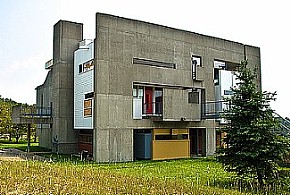
2008.06.30 15:24
the Miller House (should be more famous)
"Ah, Detailotheca, the nimiety of detail museum."
"If only all architecture were so self-evident."
"I know. It never really was a house, was it?"
"True, but it's actually two museums."
"Ah yes, the Reenactment of Late Le Corbusier Style Museum as well."
2008.07.24 10:03
Iconography, or the problem of representation
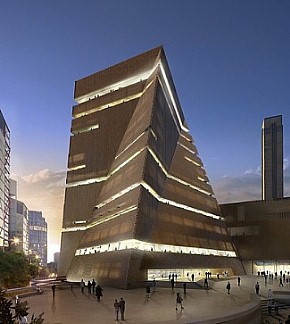
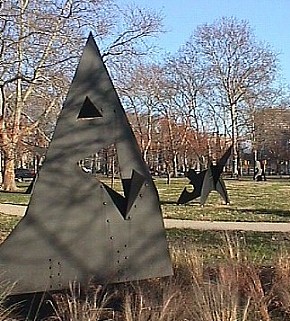
"Additionally, there is an exhibit of three Calder sculptures within the forecourt of the Rodin Museum. I found myself really admiring all these sculptures because I now see a 'real' virtual architecture in them." --2002.11.20
So maybe there really is a Calder Museum of Virtual Architecture.
| |
2008.07.26 09:18
I smell a Vorläufer
"A further study of the main house resulted in two radical options: a vertical and horizontal house, both based on the same configuration. ... By turning our initial proposal 90 degrees a vast potential was discovered in which each space can have its own personal relationship with the landscape. What used to be a conventional patio becomes a centrally located multi-level living space which gives the inhabitants an unprecedented special experience and at the same time fits the very specific demands of the program."
--description of OMA's Ascot Residence (2003).
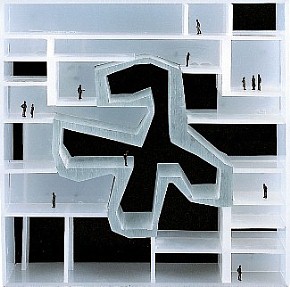
Wonder what would happen (if anything) when the above "nine plans" are flipped up 90 degrees. For example, a flipped-up 21st Century Museum of Art...
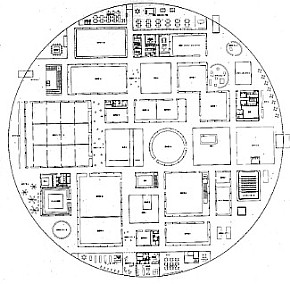 ...looks almost like this...
...looks almost like this...

One easy way to conceptualize a new paradigm is to invert the "set of assumptions, concepts, values, and practices that constitutes a way of viewing reality".
...or just practice the twist in front of the mirror[-copy plan].
2008.05.19: "I'm secretly working on Plan Atypical"
|